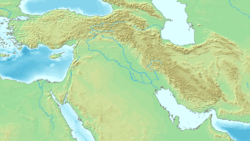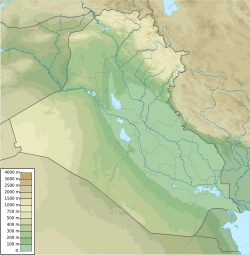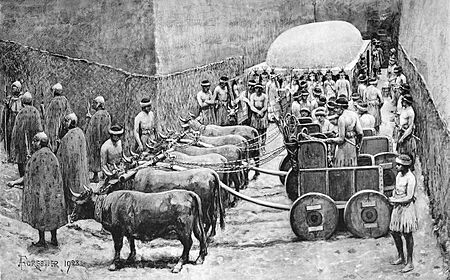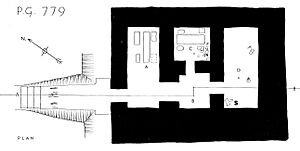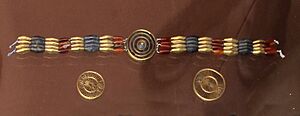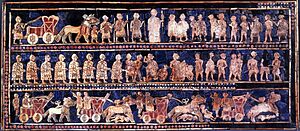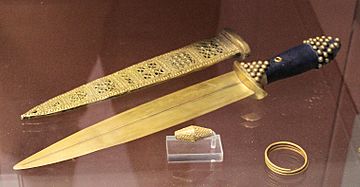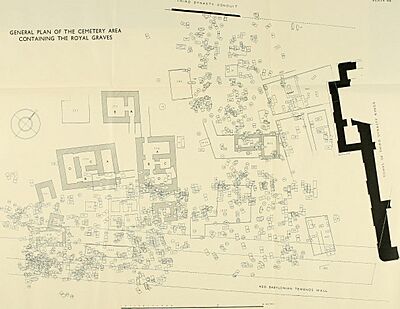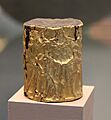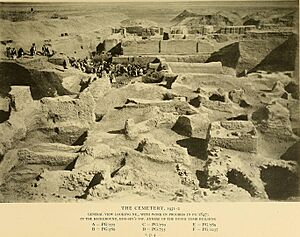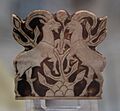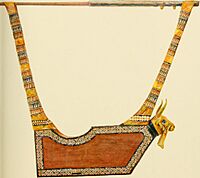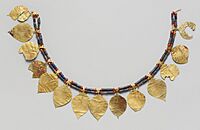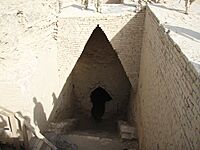Royal Cemetery at Ur facts for kids
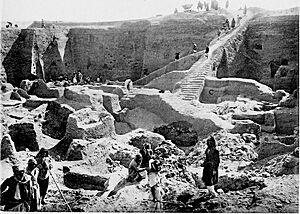
A general view of the Royal Cemetery at Ur during its discovery.
|
|
| Location | Tell el-Muqayyar, Dhi Qar Province, Iraq |
|---|---|
| Region | Mesopotamia |
| Coordinates | 30°57′41″N 46°06′22″E / 30.9615°N 46.1061°E |
| Type | Settlement |
| History | |
| Founded | c. 3800 BC |
| Abandoned | After 500 BC |
| Periods | Ubaid period to Iron Age |
| Cultures | Sumerian |
| Site notes | |
| Excavation dates | 1853–1854, 1922–1934 |
| Archaeologists | John George Taylor, Leonard Woolley |
The Royal Cemetery at Ur is an ancient burial ground in southern Iraq. It is a very important archaeological site. Leonard Woolley led the main excavations there. This happened between 1922 and 1934. His team worked with the British Museum and the University of Pennsylvania Museum.
Many amazing objects found here are now in museums. You can see them in the Iraq Museum in Baghdad and the British Museum in London.
Contents
How the Cemetery Was Found
The discovery began in 1922. Archaeologists started by digging test trenches. This helped them understand the old city's layout. Katharine Woolley drew maps of their findings.
In one trench, they found nothing at first. But the lead archaeologist, Leonard Woolley, decided to dig deeper. There, they found clay pots, stone bowls, small bronze items, and beads. Woolley thought there might be gold beads. To encourage workers to hand them over, he offered money. This led to finding gold beads that workers had sold and then bought back!
Finding the cemetery was not easy. The local workers were new to archaeology. Woolley even stopped digging in the "gold trench" for four years. He waited until the workers learned more about digging carefully. Also, archaeology was a new field back then. Experts sometimes made mistakes. For example, some gold items were first thought to be much newer than they actually were. They were from around 2300 BC, not 700 BC.
The cemetery at Ur had over 2000 burials. Woolley identified sixteen of these as "royal" tombs. He called them royal because of their large size, special structure, and many rich treasures. They also had signs of large ceremonies.
The Ancient Site of Ur
The old city of Ur is now in the desert of southern Iraq. It was abandoned long ago. This happened after the Euphrates River changed its path. Early archaeologists found graves by digging into the surface. Some graves even had royal names on them.
Woolley started his main dig in 1922. But the actual cemetery and its royal tombs were found four years later. This large cemetery was used for at least 300 years. This was during the second half of the third millennium BC. Most graves were for single people. They were sometimes dug into older graves. Bodies of both men and women were found. They had belongings that showed if they were rich or poor.
Woolley first found 1850 graves. Later, he found 260 more. But sixteen of them were very special to him. They stood out because of their wealth, burial structure, and rituals. He believed the stone rooms and valuable treasures belonged to royalty. These main bodies had many items for their needs in the afterlife.
Other people buried with them were not treated the same way. They had fewer or no goods. They were seen as part of the main person's funeral. When the main body was buried, other people might have been sacrificed. They were buried to accompany the main person.
Woolley found a large burial area called the Great Death Pit (PG 1237). It was not in good shape. Only a few stones remained, plus some gold, lapis lazuli, and carnelian beads. This pit was an open, square space. It held the bodies of armed men and women. Some believe this practice started with King Meskalamdug. He might have begun burying soldiers and women to join him in the afterlife. Some also think the Great Death Pit was the tomb of Mesannepada.
Queen Puabi's Tomb

One royal tomb at Ur was found almost completely intact. This was Queen Puabi's tomb. Her treasures were mostly untouched. It was easy to identify her body. She wore jewelry made of gold, silver, lapis lazuli, carnelian, and agate beads.
The biggest clues to her royal title were a cylinder seal with her name. She also had a crown made of gold ornaments. These were shaped like flowers. Woolley found a ramp leading down to her burial pit. It was about twelve by four meters. Inside, he found many bodies. These included armed men and women with fancy headdresses.
As he went down, he saw traces of reed mats. These mats covered the treasures and bodies. They protected them from the soil. Two meters below the pit was a stone tomb chamber. It had no door in its walls. The only way in was through its roof. Inside, four bodies rested. The most important one was clearly the queen's.
Burial Customs
The bodies at the Royal Cemetery followed special burial customs. The main person was placed inside a tomb chamber. They were usually joined by attendants. More bodies were also buried. These were often in separate rooms or in 'death pits.' These pits were open, sunken areas.
Some tombs had as few as six sacrificed bodies. Others had between seventy and eighty bodies. The attendants were usually laid in neat rows. We don't know if they died in those positions or were placed there after death. The main body was always on a mat made of reeds. These reeds also lined the floor and walls of the pit.
In some tombs, bodies were arranged in very specific ways. Some male skeletons with helmets and spears were found. They were positioned like guards in front of the entrance. Female attendants were found inside.
We are not entirely sure who the main buried people were. But it is generally thought they were royalty. The people buried together might have been related. There isn't much written evidence to explain these tombs. But it's believed that royal burials involved ceremonies lasting many days.
Some bodies show signs of heating or smoking. This might have been an attempt to preserve them for the long ceremony. Also, mercury was found on some skulls. This could also mean they tried to preserve the bodies. Music, crying, and feasting also took place.
In the first part of the ceremony, the body was placed in the tomb. Offerings were put with it. Then, the tomb was sealed with brick and stone. In the next part, the death pits were filled. Guards, attendants, musicians, and animals like oxen or donkeys were placed there.
How the attendants ended up buried with royalty is not fully known. Woolley thought they willingly drank poison. This was so they could keep serving their leader in death. Each attendant had a small cup nearby. They could have used it to drink the poison. The poison might have been a sedative. The cause of death could have been suffocation when the chamber was sealed.
Treasures from the Graves
The cemetery at Ur had over 2000 burials. It also had many valuable objects. Many of these items came from the royal burials. A lot of these treasures were brought from other places. These included Afghanistan, Egypt, and the Indus valley. Important objects included cylinder seals, jewelry, metalwork, pottery, and musical instruments.
Cylinder Seals
Cylinder seals were often found in the graves. They were sometimes carved with the names of the people buried. Three cylinder seals were found near Queen Puabi's body. One of them had her name written in cuneiform, an ancient writing system.
Jewelry and Metalwork
Many women and attendants buried at Ur wore jewelry. It was made from gold, silver, lapis lazuli, and carnelian. This included necklaces, earrings, headdresses, and hair rings. Finding carnelian beads showed that Ur traded with the Indus Valley.
Hair ornaments included combs with gold leaves. They also had lapis, shell, and pink limestone. Gold and silver hair ribbons were found too. Some combs had rosettes (flower shapes) on them.

Many jewels had designs inspired by plants. These included wreaths made with gold leaves. Queen Puabi's headdress had four plant-themed wreaths. They featured rosettes or stars and leaves.
Other precious metals were found as helmets, daggers, and various containers. These were made of copper, silver, and gold. A gold helmet was found. It might have belonged to Meskalamdug. This helmet was made from a single piece of gold. It was shaped to look like a wig.
The discovery of a weapon made from electrum (a gold-silver mix) shows advanced metalworking. Another important weapon was the "Dagger of Ur." Woolley said it was the first major treasure found. Its sheath and blade are gold. The handle is lapis lazuli with gold decoration.
Other metal items included golden cups and vessels. Some had twisted wire handles. Some vessels had carved designs. Hammered metal items were also found. This included a shield ornament. It showed lions and men being trampled. Other objects were a silver fluted bowl and a silver model of a boat.
Pottery
The pottery at Ur mostly included jars and bowls. There wasn't a lot of variety in their style. Conical bowls were found in two main types. Woolley identified 24 different pottery types. He found these from digging up 238 graves. To figure out the age of the pottery and burials, scholars compared them to pottery from other sites. They also used cylinder seals for dating.
Musical Instruments
Among the finds at Ur were remains of beautifully decorated musical instruments. Several lyres were found in the main pit. Four women were buried with them. Most of these instruments were wooden. They had silver overlays and other details.
One lyre's sound box was silver. It had blue and white mosaic details. It also had engraved shell with pictures. This lyre had a silver cast cow's head. It also had silver tuning rods. Another lyre was shaped like a boat. It held a statue of a stag. Yet another lyre used wood, shell, lapis lazuli, red stone, silver, and gold. The lyres often had animal figures. These included a cow, stag, bearded bull, and a calf. The Bull-headed lyre from PG 789 is very famous. Woolley thought each animal might match the instrument's sound.
Ram in a Thicket
Two goat statues were found in PG 1237. These are examples of colorful sculptures from Ur. Woolley called them "rams in the thicket." They were made of wood. They were covered in gold, silver, shell, and lapis lazuli.
The Ram in a Thicket uses gold for the tree, legs, and goat's face. Silver is used for the belly and parts of the base. Pink and white mosaics are also present. The back of the animal is made of shell. It is attached with bitumen. Details like the eyes, horns, and beard are made from lapis lazuli.
The Standard of Ur
In tomb PG 779, a special object was found. It is called the Standard of Ur. Its exact use is still debated. Woolley thought it was a military standard, which is why it has its name.
The Standard of Ur is a wooden box shaped like a trapezoid. It has lapis lazuli, shell, and red limestone designs. These show different figures. On each side, the pictures tell a story. They are divided into three sections. All figures are on a common ground. Important figures are shown larger.
On one side, starting from the bottom, men carry goods or lead animals and fish. They move towards the top section. There, larger figures sit and feast. Musicians and attendants are with them. The other side shows a war scene. Men in chariots run over fallen bodies. Soldiers and prisoners move up towards the top. The main person is very large, showing their importance.
Ur Today
New Ideas
Experts have studied Sir Leonard Woolley's findings again. This has led to new ideas about the royal tombs.
In 1998, Paul Zimmerman studied the Royal Cemetery at Ur. Woolley believed graves PG789 and PG800 were for a king and queen. He thought they were complete burials with attendants and treasures. Zimmerman looked at the layout. He suggested that these two tombs were actually three. Pit PG800 had two rooms on different levels. Zimmerman found this different from grave PG789, where rooms were connected.
Woolley also said Puabi's grave was built after the king's. This was so she could be close to him. But Zimmerman thinks Puabi's grave was built first. This is because it was 40 cm lower than the king's. With these ideas, Zimmerman suggested that the death pit linked to Queen Puabi might belong to a different, unknown grave.
Condition of the Royal Tombs
Stealing from archaeological sites used to be a big problem. It was controlled during Saddam Hussein's rule. His government made it a serious crime. But because of the Iraq War, looting happened more often. Entire sites were destroyed. Tens of thousands of holes were dug by looters.
However, the "Royal Cemetery At Ur" has been mostly saved. The site was inside the Tallil Air Base. This base was controlled by allied forces. It was damaged during the first Gulf War when the air base was bombed. In 2008, a team of scholars found that the walls of the royal tombs were starting to fall apart. The military's presence also caused damage.
But neglect was seen as the most harmful factor. Elizabeth Stone said that for 30 years, the "Iraq Department of Antiquities" lacked resources. They couldn't properly check and protect the site. As a result, sites like the Royal Cemetery at Ur began to erode.
In May 2009, "Iraq's State Board of Antiquities" took back control. This has helped with protecting the ancient site.
Important Graves
Many individual graves and a few royal graves have been found at Ur. It's hard to be sure who the royal graves belonged to. But some efforts have been made to match them with known rulers. Julian Reade has suggested who might be buried in the main tombs:
| Main Tombs at the Royal Cemetery of Ur | ||
| PG 1236 | A-Imdugud, a king. This is the oldest and largest tomb at the cemetery. | |
| PG 779 | Ur-Pabilsag, a king, son of A-Imdugud. | |
| PG 777 | Tomb of a queen, wife of Ur-Pabilsag. | |
| PG 755 | Tomb of king Meskalamdug. Or possibly a prince with the same name. | |
| PG 1054 | Tomb of Nibanda, queen of Meskalamdug. | |
| PG 1130 | Widow of the prince in tomb PG 755. | |
| PG 789 | Tomb of King Meskalamdug, son of Ur-Pabilsag. | |
| PG 800 | Tomb of Puabi, second wife of Meskalamdug. She was identified as a queen. | |
| PG 1050 | Tomb of Ashusikildingir, wife of Meskalamdug. | |
| PG 1332 | Tomb of Akalamdug, a king, son of Meskalamdug. | |
| PG 337 | Tomb of a queen, second wife of Akalamdug. | |
| PG 1232/1237 | Tomb of Mesannepada, son of Meskalamdug. | |
| PG 55 | Tomb of a queen, wife of A'anepada. | |
| PG 580 | Tomb of A'anepada, a king, son of Mesannepada. | |
| PG 1157 | Tomb of Meskiagnuma, a king, son of Mesannepada. | |
Tomb PG 1236
Tomb PG 1236 is a double tomb. It is the largest and likely the oldest tomb at the cemetery. It dates to around 2600 BCE. It might belong to an early king of Ur named A-Imdugud. His inscribed seal was found in the tomb.
Several artifacts come from tomb PG 1236. Two inscribed seals were found. One shows a banquet scene. The other shows a hero fighting lions and a war scene. This is similar to the Standard of Ur. Gold leaves with designs were also found. A reconstructed gold scepter was found too.
Tomb PG 779
PG 779 is an early large grave. It is linked to King Ur-Pabilsag. He was an early ruler of Ur in the 26th century BCE. He is not on the Sumerian King List. But he is known from an inscription found in Ur. It calls him "Ur-Pabilsag, king of Ur." His tomb might be grave PG 779. He may have died around 2550 BCE.
This tomb is usually seen as the second oldest at the site. It was probably built around the same time as grave PG 777. That tomb is thought to be for his queen. Meskalamdug (from grave PG 755 or PG 789) was his son.
Several artifacts are known from tomb PG 779. These include the famous Standard of Ur and decorated shell plaques.
PG 755: "Prince Meskalamdug"
PG 755 is a small individual grave. It has no attendants. It is usually linked to King Meskalamdug. But because it lacks royal features, some think it might belong to a prince. Perhaps a son of Meskalamdug.
The tomb held many gold artifacts. This included a golden helmet with the king's name. The items in this royal grave show that this ancient civilization was very rich. Meskalamdug was probably the father of King Mesannepada of Ur. Mesannepada is mentioned in the king list and other writings.
-
Alabaster vases and a helmet from the grave of Meskalamdug, grave PG 755.
Tomb PG 1054: "Queen of Meskalamdug"
This grave has many features of a royal burial. It is thought to belong to Nibanda, who was Queen of Meskalamdug.
Tomb PG 789: "the King's Grave"
Julian Reade believes tomb PG 755 was for a "Prince Meskalamdug." But the actual tomb of King Meskalamdug is more likely royal tomb PG 789. This tomb is called "the King's grave." It contained the remains of many royal attendants and beautiful objects. It is right next to the tomb of Queen Puabi. She is thought to be the second wife of King Meskalamdug.
Tomb PG 800: "Queen Puabi"
This is the tomb of Queen Puabi. It is next to tomb PG 789. She is thought to be the second wife of Meskalamdug.
Tomb 1237: "the Great Death Pit"
Julian Reade suggests that tomb PG 1237, known as "the Death-Pit," might belong to King Mesannepada.
Tomb PG 580
This might be the tomb of A'anepada, a king and son of Mesannepada.
Images for kids
See also
- Lagash
- Lyres of Ur
- Music of Mesopotamia


